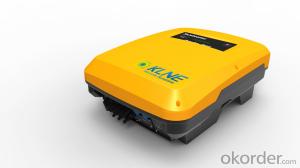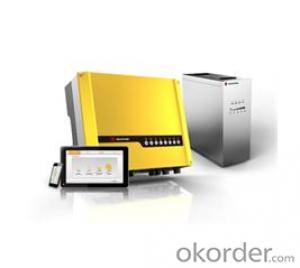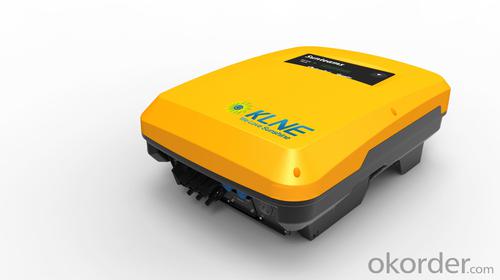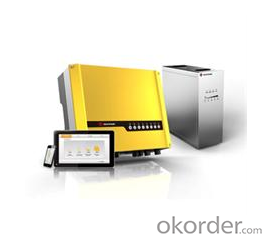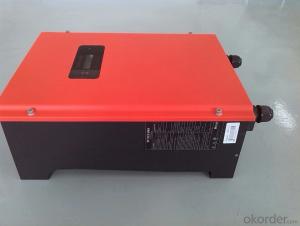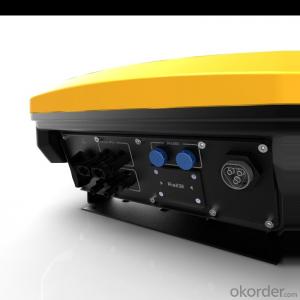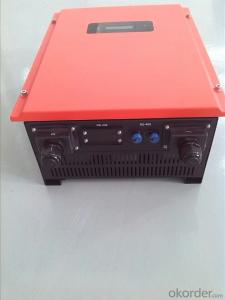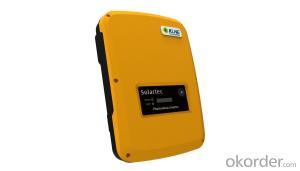40 Kw Solar Inverter Off Grid Type Solo-5000 Series
- Loading Port:
- Shanghai
- Payment Terms:
- TT OR LC
- Min Order Qty:
- 10 unit
- Supply Capability:
- 1000 unit/month
OKorder Service Pledge
OKorder Financial Service
You Might Also Like
Product Description:
This system can keep 10 energy-saving bulbs with 15W working for 5 hours per day and a 5W radio working for 8 hours a day. The AC load can keep a 33in color TV (90W) working for 5 hours, a 70W phonograph record machine working for 5 hours, a 200L fridge (180W) working a whole day, a fan less than 60W running for 5 hours, a 300W computer working for 4 hours, two 100W laptops working for 5 hours, a 1000W water heater running for 1 hour, and another 500W appliance running for 3 h.
It can work for 3 successive rainy days.
● System voltage: 110V
● Output: 220VAC/50Hz
● Power: 5000VA
● Dimensions of the box: 600 X 2000 X 600mm
● Net weight: 255kg
Product Datasheet:
Main Accessories | Specifications | No. | Notes |
Inverter | Solo-5000 | 1 | Standard |
PV modules | Polysilicon 85Wp | 40 pieces | Optional |
Storage battery | Lead acid, maintenance-free, 2V/450Ah | 55 pieces | Optional |
Controller | Solo-VS110V/50A | 1 unit | Optional |
PV accessories shelf | Customized | 1 set | Optiona |
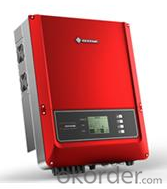
Product Advantages:
Powered by DC current
Can used out of doors
High effiency and low noise
FAQ
What is your payment terms?
We accept T/T payment, normally we need 20% T/T in advance, 80% payed before shipment.
What is your packing system?
We put the sistem in the wooden box.
Can you do OEM service?
Yes we can, but we need to do it with a certain order quantity.
- Q: Can a solar inverter be used with a solar-powered water pumping system?
- Yes, a solar inverter can be used with a solar-powered water pumping system. A solar inverter is responsible for converting the direct current (DC) electricity generated by the solar panels into alternating current (AC) electricity, which is required to power the water pump. Therefore, a solar inverter is a crucial component in ensuring the efficient operation of a solar-powered water pumping system.
- Q: What is the role of reactive power control in a solar inverter?
- The role of reactive power control in a solar inverter is to maintain the power factor of the system by managing the flow of reactive power. This helps to improve the overall efficiency and stability of the solar power generation system. Reactive power control ensures that the inverter can supply or absorb the necessary reactive power to balance the system, compensate for reactive power losses, and meet the grid requirements.
- Q: Can a solar inverter be used with different types of solar charge controllers?
- No, a solar inverter cannot be used with different types of solar charge controllers. The solar inverter and charge controller need to be compatible and specifically designed to work together for optimal performance and efficiency.
- Q: Can a solar inverter be used with a solar-powered CCTV system?
- Yes, a solar inverter can be used with a solar-powered CCTV system. A solar inverter is responsible for converting the direct current (DC) produced by solar panels into alternating current (AC) that can be used to power electrical devices. In the case of a solar-powered CCTV system, the solar inverter can convert the DC power generated by the solar panels into the AC power required to run the CCTV system, ensuring it functions properly.
- Q: What is the role of a solar inverter in power quality management?
- The role of a solar inverter in power quality management is to convert the direct current (DC) generated by solar panels into alternating current (AC) suitable for use in the electrical grid. In addition to this primary function, solar inverters also play a crucial role in managing and maintaining power quality by ensuring a stable voltage and frequency output, reducing harmonics and reactive power, and providing grid support functions such as voltage regulation and power factor correction.
- Q: Can a solar inverter be used with a solar-powered desalination system?
- Yes, a solar inverter can be used with a solar-powered desalination system. A solar inverter is responsible for converting the direct current (DC) produced by solar panels into alternating current (AC) that is required to power electrical devices. In the case of a solar-powered desalination system, the solar panels generate DC electricity, which is then converted by the inverter to AC power to operate the desalination system's pumps, motors, and other electrical components. This allows the system to utilize solar energy efficiently and sustainably for the desalination process.
- Q: What is the role of a solar inverter in a microgrid system?
- The role of a solar inverter in a microgrid system is to convert the direct current (DC) electricity generated by solar panels into alternating current (AC) electricity that can be used to power the various loads within the microgrid. It also manages the flow of electricity between the microgrid and the utility grid, allowing for bidirectional power flow and enabling the system to operate in both grid-connected and islanded modes. Additionally, the solar inverter ensures the stability and quality of the electricity supply, regulating voltage and frequency levels to match the requirements of the microgrid.
- Q: Can a solar inverter be used for commercial applications?
- Yes, a solar inverter can definitely be used for commercial applications. In fact, solar inverters are commonly utilized in commercial settings to convert the direct current (DC) electricity generated by solar panels into usable alternating current (AC) electricity that can power various commercial appliances and equipment.
- Q: How does the input voltage range affect the performance of a solar inverter?
- The input voltage range directly affects the performance of a solar inverter. A wider input voltage range allows the inverter to accommodate a greater variety of solar panel configurations and fluctuations in solar energy production. This flexibility ensures optimal operation and increased energy conversion efficiency, resulting in better overall performance. On the other hand, a narrow input voltage range restricts the inverter's compatibility and may lead to reduced efficiency and output power.
- Q: How is the size of a solar inverter determined?
- The size of a solar inverter is typically determined by the total capacity of the solar panels it needs to handle. The inverter should have a capacity slightly higher than the total wattage of the solar panels to ensure efficient conversion of the DC power produced by the panels into usable AC power for household or grid consumption.
Send your message to us
40 Kw Solar Inverter Off Grid Type Solo-5000 Series
- Loading Port:
- Shanghai
- Payment Terms:
- TT OR LC
- Min Order Qty:
- 10 unit
- Supply Capability:
- 1000 unit/month
OKorder Service Pledge
OKorder Financial Service
Similar products
Hot products
Hot Searches
Related keywords
